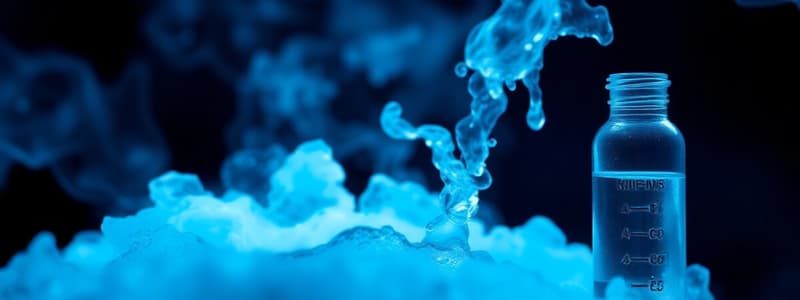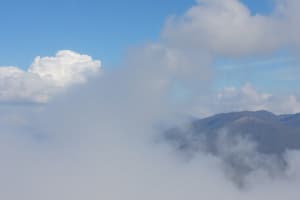Podcast
Questions and Answers
What was the primary composition of the Earth's primitive atmosphere?
What was the primary composition of the Earth's primitive atmosphere?
- Hydrogen and helium with simple compounds (correct)
- Nitrogen and oxygen
- Methane and water vapor
- Carbon dioxide and ammonia
Which event contributed significantly to the formation of the secondary atmosphere on Earth?
Which event contributed significantly to the formation of the secondary atmosphere on Earth?
- The formation of the ozone layer
- The collision of Earth with asteroids
- Volcanic activity releasing gases (correct)
- The extinction of dinosaurs
What was the role of water vapor in the early secondary atmosphere?
What was the role of water vapor in the early secondary atmosphere?
- To condense and form clouds and oceans (correct)
- To contribute to climate change
- To increase the levels of carbon monoxide
- To create a protective layer against solar winds
Which gases were primarily produced from the breakdown of ammonia in the early atmosphere?
Which gases were primarily produced from the breakdown of ammonia in the early atmosphere?
How did the early Earth lose its primitive atmosphere?
How did the early Earth lose its primitive atmosphere?
What process led to the formation of oxygen in the atmosphere?
What process led to the formation of oxygen in the atmosphere?
Which gases were present in trace amounts in the secondary atmosphere?
Which gases were present in trace amounts in the secondary atmosphere?
What primary factor contributed to the cooling of the atmosphere leading to the formation of oceans?
What primary factor contributed to the cooling of the atmosphere leading to the formation of oceans?
What was the primary by-product of the photosynthesis performed by cyanobacteria?
What was the primary by-product of the photosynthesis performed by cyanobacteria?
Which process led to the rise in oxygen levels in the atmosphere after the oxidation of surface rocks?
Which process led to the rise in oxygen levels in the atmosphere after the oxidation of surface rocks?
What transformation occurs to O2 molecules in the atmosphere as they absorb UV radiation?
What transformation occurs to O2 molecules in the atmosphere as they absorb UV radiation?
What is the Karman Line known for?
What is the Karman Line known for?
Who are credited with the discovery of oxygen in the 1770s?
Who are credited with the discovery of oxygen in the 1770s?
Which element was discovered in the 1840s and is associated with the ozone layer?
Which element was discovered in the 1840s and is associated with the ozone layer?
What comprises the mixture of gases that makes up the atmosphere?
What comprises the mixture of gases that makes up the atmosphere?
What effect did the formation of the ozone layer have on life on Earth?
What effect did the formation of the ozone layer have on life on Earth?
What is the principal reason that hard water does not dissolve with soap effectively?
What is the principal reason that hard water does not dissolve with soap effectively?
Which of the following best describes the impact of environmental soil chemistry?
Which of the following best describes the impact of environmental soil chemistry?
What is the smallest unit of soil that includes all horizons from the surface to the underlying geologic strata?
What is the smallest unit of soil that includes all horizons from the surface to the underlying geologic strata?
Which of the following elements is the most prevalent in soils and the Earth's crust?
Which of the following elements is the most prevalent in soils and the Earth's crust?
What defines a polypedon in soil science?
What defines a polypedon in soil science?
Which cation is NOT typically associated with responsible hardness in water?
Which cation is NOT typically associated with responsible hardness in water?
In the context of soil chemistry, what are 'peds'?
In the context of soil chemistry, what are 'peds'?
Hard water typically originates from which type of geographical area?
Hard water typically originates from which type of geographical area?
What is the primary consequence of high water temperatures on fish metabolism?
What is the primary consequence of high water temperatures on fish metabolism?
Which of the following statements correctly describes the role of alkalinity in water bodies?
Which of the following statements correctly describes the role of alkalinity in water bodies?
What is the effect of thermal pollution on dissolved oxygen levels in water bodies?
What is the effect of thermal pollution on dissolved oxygen levels in water bodies?
Which factor is primarily responsible for the creation of CO2 acidity in water bodies?
Which factor is primarily responsible for the creation of CO2 acidity in water bodies?
What is a common result of low levels of dissolved oxygen in aquatic systems?
What is a common result of low levels of dissolved oxygen in aquatic systems?
What is a significant source of acidity in water from industrial activities?
What is a significant source of acidity in water from industrial activities?
How does dissolved oxygen directly contribute to aquatic ecosystems?
How does dissolved oxygen directly contribute to aquatic ecosystems?
Which of the following best describes the impact of temperature on water chemistry?
Which of the following best describes the impact of temperature on water chemistry?
What contributes to groundwater pollution in addition to sewage?
What contributes to groundwater pollution in addition to sewage?
Why is it difficult to trace the source of groundwater pollution?
Why is it difficult to trace the source of groundwater pollution?
What is the effect of not having access to air on groundwater?
What is the effect of not having access to air on groundwater?
What is thermal stratification?
What is thermal stratification?
Which layer of water is exposed to sunlight and has a higher temperature?
Which layer of water is exposed to sunlight and has a higher temperature?
What is the role of the thermocline in a thermally stratified body of water?
What is the role of the thermocline in a thermally stratified body of water?
What is a consequence of warm temperatures on the density of a water body?
What is a consequence of warm temperatures on the density of a water body?
Which of the following is NOT a factor that affects water quality?
Which of the following is NOT a factor that affects water quality?
What is the primary function of a surfactant in the leaching process?
What is the primary function of a surfactant in the leaching process?
Which of the following non-in-situ techniques involves the use of extreme heat?
Which of the following non-in-situ techniques involves the use of extreme heat?
How long can contaminants be immobilized using the vitrification method?
How long can contaminants be immobilized using the vitrification method?
What is a significant drawback of the leaching method?
What is a significant drawback of the leaching method?
Which method involves adding contaminated soil to hot asphalt?
Which method involves adding contaminated soil to hot asphalt?
What adjustment is made during land treatment to assist in the decontamination process?
What adjustment is made during land treatment to assist in the decontamination process?
What is the main concept behind solidification/stabilization techniques?
What is the main concept behind solidification/stabilization techniques?
Which of the following is a challenge posed by the thermal treatment method?
Which of the following is a challenge posed by the thermal treatment method?
Flashcards
Primitive Atmosphere
Primitive Atmosphere
The early atmosphere of Earth, primarily composed of hydrogen and helium, and simple compounds like ammonia and methane.
Secondary Atmosphere
Secondary Atmosphere
The Earth's atmosphere formed after the primitive atmosphere, mostly water vapor, carbon dioxide, and ammonia.
Oxidizing Atmosphere
Oxidizing Atmosphere
Earth's atmosphere after oxygen began to accumulate, due to chemical processes such as photochemical dissociation.
Photochemical Dissociation
Photochemical Dissociation
Signup and view all the flashcards
Earth's Early Atmosphere Composition
Earth's Early Atmosphere Composition
Signup and view all the flashcards
Reducing Atmosphere
Reducing Atmosphere
Signup and view all the flashcards
Volcanic Activity's Role
Volcanic Activity's Role
Signup and view all the flashcards
Formation of Oceans
Formation of Oceans
Signup and view all the flashcards
Ground Water Pollution Source
Ground Water Pollution Source
Signup and view all the flashcards
Ground Water Movement
Ground Water Movement
Signup and view all the flashcards
Ground Water Oxidation
Ground Water Oxidation
Signup and view all the flashcards
Thermal Stratification
Thermal Stratification
Signup and view all the flashcards
Epilimnion Layer
Epilimnion Layer
Signup and view all the flashcards
Hypolimnion Layer
Hypolimnion Layer
Signup and view all the flashcards
Thermocline Layer
Thermocline Layer
Signup and view all the flashcards
Water Quality Factors
Water Quality Factors
Signup and view all the flashcards
Hypolimnion
Hypolimnion
Signup and view all the flashcards
Dissolved Oxygen (DO)
Dissolved Oxygen (DO)
Signup and view all the flashcards
Alkalinity
Alkalinity
Signup and view all the flashcards
CO2 Acidity
CO2 Acidity
Signup and view all the flashcards
Thermal Pollution
Thermal Pollution
Signup and view all the flashcards
Metabolic Rate
Metabolic Rate
Signup and view all the flashcards
What is the main cause of low dissolved oxygen (DO) in the hypolimnion?
What is the main cause of low dissolved oxygen (DO) in the hypolimnion?
Signup and view all the flashcards
Why is alkalinity important for water?
Why is alkalinity important for water?
Signup and view all the flashcards
Cyanobacteria
Cyanobacteria
Signup and view all the flashcards
Photosynthesis Equation
Photosynthesis Equation
Signup and view all the flashcards
Oxidation of Metals
Oxidation of Metals
Signup and view all the flashcards
Ozone Layer Formation
Ozone Layer Formation
Signup and view all the flashcards
Earth's Atmosphere
Earth's Atmosphere
Signup and view all the flashcards
Karman Line
Karman Line
Signup and view all the flashcards
Atmospheric Composition
Atmospheric Composition
Signup and view all the flashcards
Discovery of Atmospheric Gases
Discovery of Atmospheric Gases
Signup and view all the flashcards
pH Level of Water
pH Level of Water
Signup and view all the flashcards
Water Hardness
Water Hardness
Signup and view all the flashcards
Soil Chemistry
Soil Chemistry
Signup and view all the flashcards
Environmental Soil Chemistry
Environmental Soil Chemistry
Signup and view all the flashcards
Soil Components
Soil Components
Signup and view all the flashcards
Peds
Peds
Signup and view all the flashcards
Soil Profiles
Soil Profiles
Signup and view all the flashcards
Pedon
Pedon
Signup and view all the flashcards
Leaching
Leaching
Signup and view all the flashcards
Vitrification
Vitrification
Signup and view all the flashcards
Land Treatment
Land Treatment
Signup and view all the flashcards
Thermal Treatment
Thermal Treatment
Signup and view all the flashcards
Asphalt Incorporation
Asphalt Incorporation
Signup and view all the flashcards
Solidification/Stabilization
Solidification/Stabilization
Signup and view all the flashcards
What is a surfactant?
What is a surfactant?
Signup and view all the flashcards
What is biodegradation?
What is biodegradation?
Signup and view all the flashcards
Study Notes
Introduction to Environmental Chemistry
- Our environment, comprising air, land, water, and climate, is complex.
- Chemistry is crucial for understanding, monitoring, protecting, and improving the environment.
- Chemists develop tools and techniques to analyze and measure pollutants in air and water.
- They also study how climate changes over time.
The Formation of the Atmosphere
- Primitive Atmosphere: Early Earth, a molten rock, had an atmosphere primarily composed of hydrogen and helium, along with ammonia and methane.
- Secondary Atmosphere: As Earth cooled, volcanic activity released gases (primarily water vapor, carbon dioxide, and ammonia) forming a reducing atmosphere, similar to that of Mars and Venus today.
- Oxidizing Atmosphere: Photochemical dissociation of water vapor by ultraviolet radiation produced oxygen, but the amount was negligible.
- Photosynthesis: Most of Earth's oxygen was produced by cyanobacteria via photosynthesis.
Atmospheric Chemistry
- Atmosphere: The thick mixture of gases surrounding Earth.
- Air: A term for the mixture of gases in the atmosphere, held near the surface by gravity.
- Karman Line: The imaginary line marking the boundary between Earth's atmosphere and outer space.
- Important Discoveries: Various elements and compounds were discovered over time (e.g., nitrogen, oxygen, carbon dioxide, argon, etc.) by different scientists.
Water Chemistry
- Water: A chemical compound (H₂O) with strong covalent bonds, a bond angle of 105 degrees in liquid water.
- Water's Properties:
- Excellent solvent due to its high dielectric strength.
- Cohesive & adhesive properties due to hydrogen bonds, leading to a high surface tension.
- High specific heat capacity.
- Expands when freezing, making ice less dense than liquid water.
- High latent heat of fusion and vaporization, enabling various phase changes.
Soil Chemistry
- Soil: A heterogeneous mixture of air, water, inorganic and organic solids, plus microorganisms.
- Inorganic Components: Primarily sand, silt, and clay particles, which aggregate to form larger soil structures and contribute to soil formation.
- Organic Components (Humus): Undecayed plant and animal remains plus their decomposition products, which are vital for soil chemistry.
- Soil Properties affected by temperature: The amount of gas that can be dissolved in water, the rate of photosynthetic action, metabolism of aquatic organisms.
- pH level of Water: The pH level of bodies of water is usually maintained between 6 and 9.5.
Water Pollution
- Surface Water Pollution: Point sources (directly affecting water bodies) and non-point sources (indirectly affecting water bodies) including natural and anthropogenic (human-made).
- Ground Water Pollution: Raw sewage, septic tanks, and other water pollutants that seep into aquifers. Sources of groundwater pollution are difficult to trace due to the large spaces below the Earth's surface.
- Water Pollutants (Types): Pathogens, organic pollutants (oils, greases, pesticides, plastics, detergents), inorganic pollutants (fertilizers, nitrates, acids), Radioactive materials, heat, and sediments.
Factors Affecting Water Quality
- Temperature impacts various chemical and biological processes in water.
- Thermal stratification (distinct layers based on temperature) affects oxygen levels, aquatic life, and other aspects of the water.
Studying That Suits You
Use AI to generate personalized quizzes and flashcards to suit your learning preferences.
Related Documents
Description
Explore the interactions between chemistry and the environment in this quiz. Delve into the formation of the atmosphere and understand the role of chemists in monitoring pollutants and studying climate changes. Test your knowledge on these foundational concepts in environmental chemistry.




